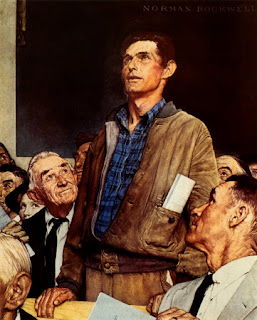It's a little known fact that Abraham Lincoln always read aloud to himself. When asked why he had this rather irritating habit, he responded, "When I read aloud two senses catch the idea; first I see what I read; second I hear it, and therefore I can remember it better." That's what this blog is, really. Sometimes it may look like I'm passing along helpful painting tips, but in reality I'm just talking to myself, trying to catch hold of an idea so I can understand it.
The idea I've been grappling with recently concerns values. Of course, we all understand values, right? It's generally speaking how light or dark something is. But as painters I think we're often more concerned with the color of an object than it's value. I know I often think if I get the color right, the value takes care of itself. But I can't tell you how many times I'd look at a passage I was painting and wonder how come it doesn't look right? The color is wrong, I'd tell myself, and proceed to intensify the chroma, thinking that will cure it. Wrong. 99 out of 100 times, it wasn't the color, but the value that was off. It could have been the background was wrong, or the object itself was too close in value for it to stand out. Whatever-- I just simply had not spent enough time establishing the values of my painting.
Here's how I came to understand the importance of value; another
analogy! Keeping with the season, here goes. Think of the tune
Jingle Bells-- You know,
Jingle bells, jingle bells, jingle all the way... It is really just four notes played in a pre-determined spacing that identifies it as
Jingle Bells, and not
The Star Spangled Banner. You can play those four notes anywhere on a piano keyboard. All white keys, or all black, or maybe a combination of black and white. As long as you play the notes at the proper intervals it will sound like
Jingle Bells. This next part is tricky-- Whether you play the notes all white, all black or a combination of both is called the Key. The key is the overall frequency that harmonizes with the notes. If you try to play the notes in two different keys at the same time, the intervals will be wrong, and it will no longer sound like
Jingle Bells. It will, however, sound just like the noise my son listens to. Now, to bring this concept back to painting. Color is the notes, value is the key. If your painting has competing values, no bright color is gonna help you. In other words, having a dark and pretty looking color in a shadow area won't look right if it's lighter than an area that's supposed to be in the light.
I decided to take this concept to the extreme with the painting I've been working on lately. It's a scene from a spot I used to live in Cundy's Harbor, Maine. This was the view from my kitchen, if I recall.
Or maybe this was the view from the bathroom. Anyway, it was a typical foggy summer day. So, to start I blocked in the rough shapes of the scene on a masonite panel.
So I could get the values as close to right as I could make it, I converted the image to black and white, then did my underpainting in B&W also.
Doing this helped me see how close I was to obtaining proper values. All I had to do with this is apply color.
I will undoubtedly tweak a few things with this painting as I sit back and asses it. Even now, I can see some things I am not entirely happy with. Each night I sit back and stare at the painting I'm working on and write notes of what I need to fix. I still have a couple things on the list, like the bottom left hand corner. Maybe I'll repost this painting when it's done for good.
Anyway, I hope this whole concept hasn't been too tough to understand, or would you rather Abe Lincoln read it to you?
.




















































